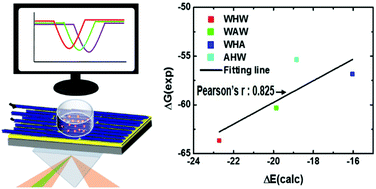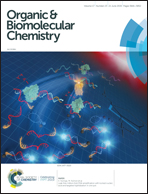Experimental and numerical evaluation of a genetically engineered M13 bacteriophage with high sensitivity and selectivity for 2,4,6-trinitrotoluene†
Abstract
Selective and sensitive detection of desired targets is very critical in sensor design. Here, we report a genetically engineered M13 bacteriophage-based sensor system evaluated by quantum mechanics (QM) calculations. Phage display is a facile way to develop the desired peptide sequences, but the resulting sequences can be imperfect peptides for binding of target molecules. A TNT binding peptide (WHW) carrying phage was self-assembled to fabricate thin films and tested for the sensitive and selective surface plasmon resonance-based detection of TNT molecules at the 500 femtomole level. SPR studies performed with the WHW peptide and control peptides (WAW, WHA, AHW) were well-matched with those of the QM calculations. Our combined method between phage engineering and QM calculation will significantly enhance our ability to design selective and sensitive sensors.

- This article is part of the themed collection: Chemical Biology in OBC


 Please wait while we load your content...
Please wait while we load your content...
